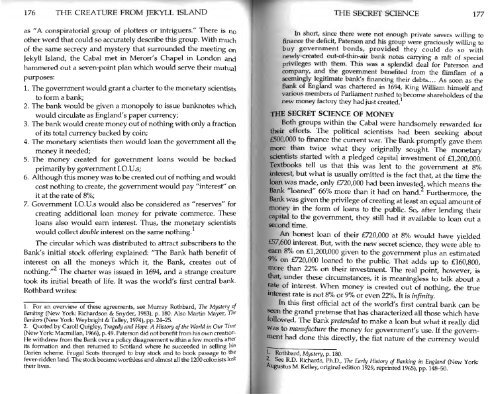Create successful ePaper yourself
Turn your PDF publications into a flip-book with our unique Google optimized e-Paper software.
176 THE CREATURE FROM JEKYLL ISLAND<br />
as "A conspiratorial group of plotters or intriguers/' There is no<br />
other word that could so accurately describe this group. With much<br />
of the same secrecy and mystery that surrounded the meeting on<br />
<strong>Jekyll</strong> Island, the Cabal met in Mercer's Chapel in London and<br />
hammered out a seven-point plan which would serve their mutual<br />
purposes:<br />
1. The government would grant a charter to the monetary scientists<br />
to form a bank;<br />
2. The bank would be given a monopoly to issue banknotes which<br />
would circulate as England's paper currency;<br />
3. The bank would create money out of nothing with only a fraction<br />
of its total currency backed by coin;<br />
4. The monetary scientists then would loan the government all the<br />
money it needed;<br />
5. The money created for government loans would be backed<br />
primarily by government I.O.U.s;<br />
6. Although this money was to be created out of nothing and would<br />
cost nothing to create, the government would pay "interest" on<br />
it at the rate of 8%;<br />
7. Government LO.U.s would also be considered as "reserves" for<br />
creating additional loan money for private commerce. These<br />
loans also would earn interest. Thus, the monetary scientists<br />
would collect double interest on the same nothing.<br />
The circular which was distributed to attract subscribers to the<br />
Bank's initial<br />
stock offering explained: "The Bank hath benefit of<br />
interest on all the moneys which it, the Bank, creates out of<br />
nothing/'<br />
The charter was issued in 1694, and a strange creature<br />
took its initial breath of life. It was the world's first central bank.<br />
Rothbard writes:<br />
1. For an overview of these agreements, see Murray Rothbard, The Mystery of<br />
Banking (New York: Richardson & Snyder, 1983), p. 180. Also Martin Mayer, The<br />
Bankers (New York: Weybright & Talley, 1974), pp. 24-25.<br />
2. Quoted by Carol! Quigley, Tragedy and Hope. A History of the World in Our Time<br />
(New York: Macmillan, 1966), p. 49. Paterson did not benefit from his own creation-<br />
He withdrew from the Bank over a policy disagreement within a few months after<br />
its formation and then returned to Scotland where he succeeded in selling his<br />
Darien scheme. Frugal Scots thronged to buy stock and to book passage to the<br />
fever-ridden land. The stock became worthless and almost all the 1200 colonists lost<br />
their lives.<br />
THE SECRET SCIENCE 177<br />
In short, since there were not enough private savers willing to<br />
finance the deficit, Paterson and his group were graciously willing to<br />
buy government bonds, provided they could do so with<br />
newly-created out-of-thin-air bank notes carrying a raft of special<br />
privileges with them. This was a splendid deal for Paterson and<br />
company, and the government benefited from the flimflam of a<br />
seemingly legitimate bank's financing their debts....<br />
As soon as the<br />
Bank of England was chartered in 1694, King William himself and<br />
various members of Parliament rushed to become shareholders of the<br />
new money factory they had just created. 1<br />
THE SECRET SCIENCE OF MONEY<br />
Both groups within the Cabal were handsomely rewarded for<br />
their efforts. The political scientists had been seeking about<br />
£500,000 to finance the current war. The Bank promptly gave them<br />
more than twice what they originally sought. The monetary<br />
scientists started with a pledged capital investment of £1,200,000.<br />
Textbooks tell us that this was lent to the government at 8%<br />
interest, but what is usually omitted is the fact that, at the time the<br />
loan was made, only £720,000 had been invested, which means the<br />
Bank "loaned" 66% more than it had on hand. 2 Furthermore, the<br />
Bauik was given the privilege of creating at least an equal amount of<br />
money in the form of loans to the public. So, after lending their<br />
capital to the government, they still had it available to loan out a<br />
second time.<br />
An honest loan of their £720,000 at 8% would have yielded<br />
£57,600 interest. But, with the new secret science, they were able to<br />
earn 8% on £1,200,000 given to the government plus an estimated<br />
9% on £720,000 loaned to the public. That adds up to £160,800,<br />
more than 22% on their investment. The real point, however, is<br />
that, under these circumstances, it is meaningless to talk about a<br />
rate of interest. When money is created out of nothing, the true<br />
interest rate is not 8% or 9% or even 22%. It is infinity.<br />
In this first official act of the world's first central bank can be<br />
seen the grand pretense that has characterized all those which have<br />
followed. The Bank pretended to make a loan but what it really did<br />
was to manufacture the money for government's use. If the government<br />
had done this directly, the fiat nature of the currency would<br />
I Rothbard, Mystery, p. 180.<br />
I See R.D. Richards, Ph.D., The Early History of Banking in England (New York-<br />
Augustus M. Kelley, original edition 1929, reprinted 1965), pp. 148-50.


